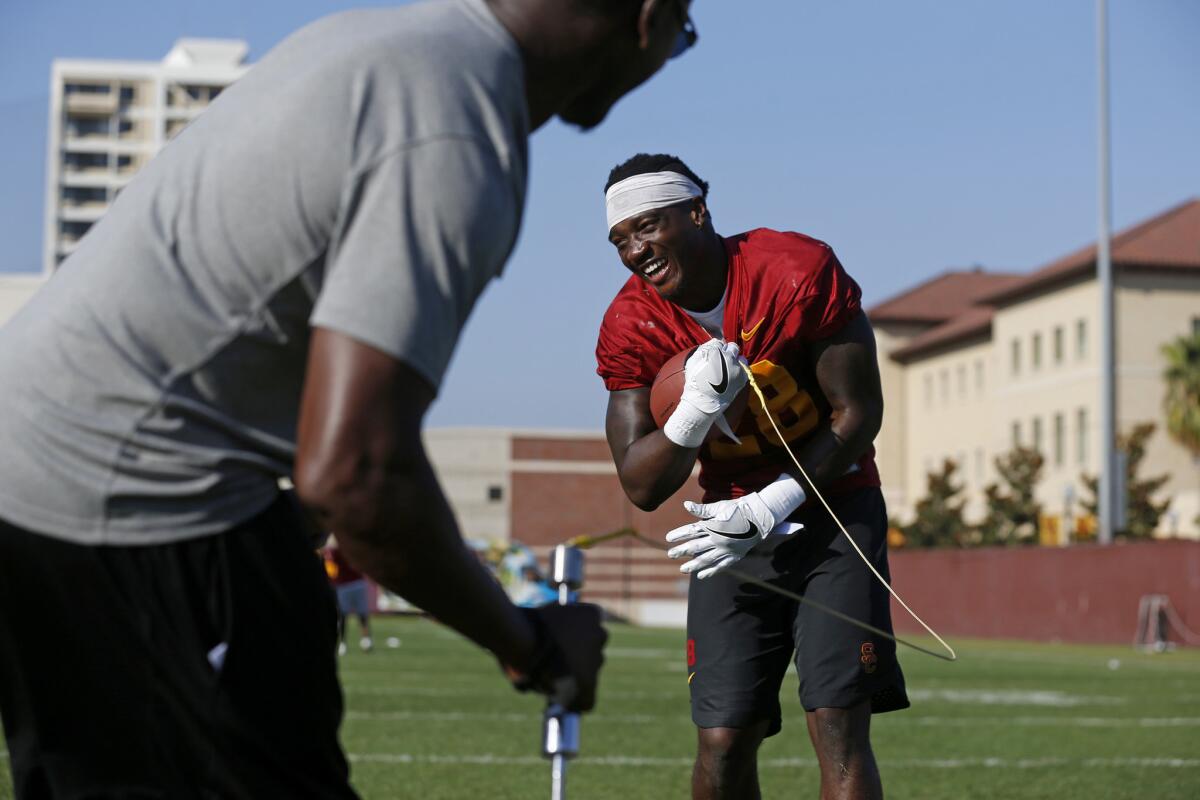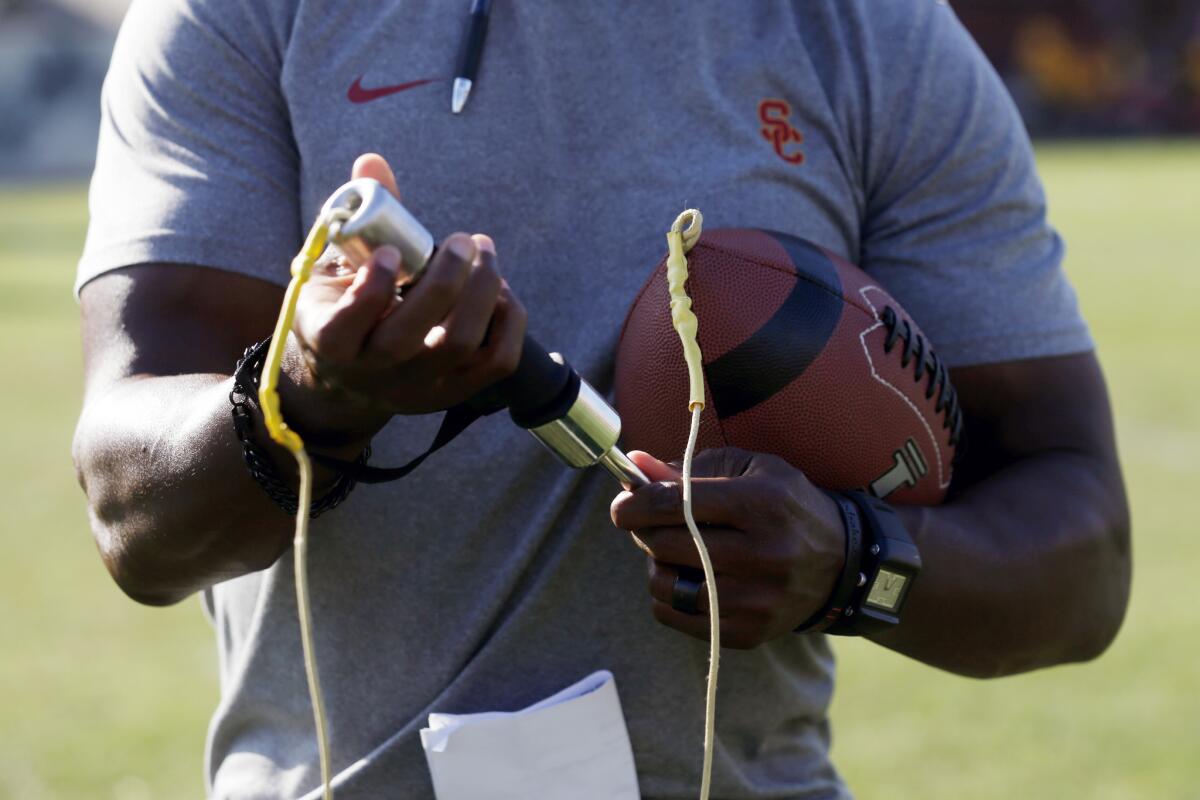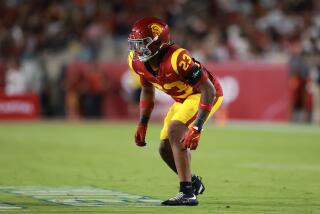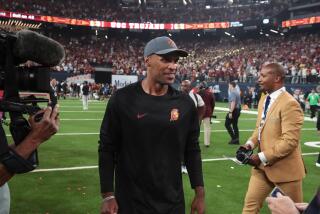To eliminate mistakes, USC acts like a startup: ‘I came up with this new app,’ Tee Martin says

- Share via
Like an entrepreneur entering a venture capitalist’s boardroom, USC offensive coordinator Tee Martin walked into a recent receivers meeting with an announcement.
“He said, ‘Uh, I came up with this new app,’” receiver Deontay Burnett recalled.
As of Wednesday, the receivers had it downloaded onto their phones and iPads, swiping through quizzes of alignments, route concepts or whatever strikes Martin’s fancy.
“It has you really thinking on the fly,” Tyler Vaughns said, adding that he currently held the top score. “So, yeah, I like it.”
The application is part of a program-wide goal, laid out last spring by coach Clay Helton. His top priority, he said, was eliminating the mental mistakes, penalties and fumbles that plagued his team as it stumbled to a 1-3 start a year ago.
It sounds simple. Don’t want offsides penalties? Don’t jump offsides. Don’t want to fumble? Hold onto the ball tighter. But translating desires to results required ingenuity. After all, no one wants to fumble.
USC’s coaches responded to the vision as if they were on “Shark Tank.” They innovated. They created apps and inventions. Players took pop quizzes and vocal training.
The Trojans are betting that the investment and creativity will reverse a bad trend. USC last season ranked 113th in the nation in penalties per game (7.6) and 114th in penalty yardage (67).
The season’s start was particularly sloppy. In the first half of the season, USC lost the turnover battle by the equivalent of more than four points a game, on average, according to the advanced statistics website bcftoys.com.
On one embarrassing series, a blown coverage left Stanford’s All-American running back Christian McCaffrey uncovered for a long touchdown pass. The next play, USC fielded only eight players on the extra point.
Helton decided the best way to stanch the unforced mistakes was to spark ideas. Helton runs a relatively flat organization. He does not micromanage. The result is an agile unit, like a startup.
“I don’t try to handcuff coaches into saying, ‘Hey, you have to do it this way,’” Helton said. “I hired them to do their job and trust them to do their job.”
Johnny Nansen, who coaches the linebackers, uses quizzes on an overhead projector, like a high school teacher. In meetings, he calls on players to answer in front of the class.
“So you really want to not mess up there,” linebacker Porter Gustin said.
Martin got the idea for his application over the summer. He approached Eric Espinoza, USC’s director of football video operations, about the concept, and they hired a local company to write the code. Martin started with the receivers and hopes to roll it out to the entire offense.
“This is not the paper-and-pen generation,” Martin said. “This is the thumb generation. So I had to adapt as a teacher and try to find a way to relate to them.”
The application tests players’ knowledge of offensive concepts to eliminate issues such as blown routes and missed hot reads.
“I get real live feedback,” Martin said. “I know if you were on it for 30 minutes or you just checked it for five minutes and got off. And I know if you keep missing the same one so tomorrow I need to talk you.”
There wasn’t an in-house solution to combat fumbles. But Helton noticed that Indiana rarely fumbled, its running backs losing only four last season. So when USC needed a running back’s coach, Helton hired Indiana’s Deland McCullough.
McCullough brought along strange tools. During warmups and drills, his backs use footballs he designed. He devised the invention one day at Indiana, when a friend mused: What if we filled a football with water?
McCullough worked with Indiana’s equipment team to find out. He filled balls 80% with water. He said he doesn’t know how much extra the balls weigh, precisely, but Deflategate-honed math skills estimate that they are about seven to eight pounds heavier. The key, he said, is the extra air, which allows the water to slosh around.
Running back Ronald Jones II holds the water ball in his left hand on the sidelines during practice to build his forearm muscles.
“It’s like an ankle-weight effect,” McCullough said. “When you take that ball and go to a regular football, you’re just crushing it.”
McCullough also uses what he calls “punch sticks” — plastic pipes with boxing gloves at the end — to try to knock footballs loose.
After practice Thursday, cornerback Jack Jones happened by McCullough demonstrating yet another gadget, this time designed by a company called Fumble Pro. It’s a football with a long string protruding from the nose. Jones was intrigued.
I can handle that, he proclaimed. McCullough let him try.

As Jones ran in place, McCullough yanked on the string. Unless a player covers all four points of the ball, he said, the ball will come loose.
“It gives you immediate feedback,” McCullough said.
Helton reported that fumbles have declined significantly in training camp.
The plan for USC’s defense relies more on experience than innovation. Gustin, the linebacker, explained that breakdowns happened last year because the unit was adjusting to a new system with new plays. Now, it is stocked with veterans.
But Helton did supply them with data. During the offseason, he asked the Pac-12 Conference for statistics on penalties, and the staff crunched which ones nagged USC most often.
The offense and defense both struggled with holding. Sometimes, safety Chris Hawkins explained, “We get a little handsy.” So secondary coach Ronnie Bradford came to practice this week with another tool: boxing gloves, to prevent grabbing.
Still, there is no inventive fix for some issues. Quarterback Sam Darnold said he can prevent false starts by simply yelling his cadence louder.
“In high school, games weren’t nearly as loud as some of the games we play in college,” Darnold said. “So I’ve definitely got to work on it.”
Sometimes, tight end Daniel Imatorbhebhe said, the old-fashioned method works best. Asked if the coaches had any inventions to keep the Trojans onside, he shook his head.
“No,” he said. “They just yell at you.”
Follow Zach Helfand on Twitter @zhelfand
More to Read
Go beyond the scoreboard
Get the latest on L.A.'s teams in the daily Sports Report newsletter.
You may occasionally receive promotional content from the Los Angeles Times.







